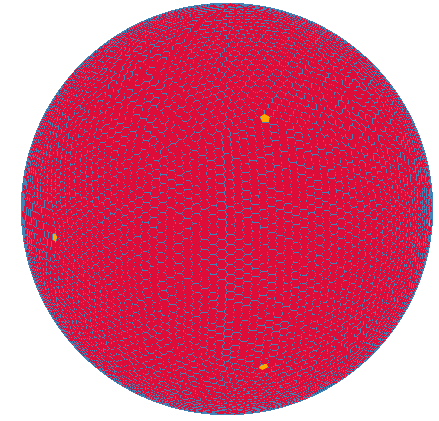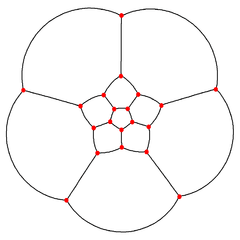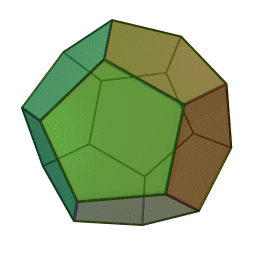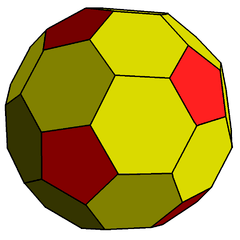I believe I have a solution for this challenge. It relies on d3's geographic features: projections and pathing along great circles, d3-delaunay (a voronoi generator) and d3-geo-voronoi (a geographical voronoi extension to d3-delaunay).
The approach I've taken is fairly simple:
- Take the centers of the faces of a regular dodecahedron (as lat/long pairs).
Create a spherical voronoi diagram of the centers (replicating the dodecahedron, contained in a sphere)
If more chamfering is needed, calculate the midpoint of each edge of the spherical voronoi diagram, add these to the list of centers, go back to step 2.
Project and draw
Using the midpoint from each edge as a new face center creates a new face for every edge when running through the voronoi generator. This chamfering is fairly regular, the midpoint of each edge should be in the middle of a new face when chamfering. This does not mean the hexagons are regular, hexagons cannot be regular when chamfering twice or more (if I'm not mistaken).
Here's the implementation in 837 bytes:
<input><input><p>d</p><canvas><script src="https://d3js.org/d3.v4.js"></script><script src="https://unpkg.com/d3-delaunay@2"></script><script src="https://unpkg.com/d3-geo-voronoi"></script><script>_="canvas",O=d3,$=O.select,$("p").on("click",()=>{N=O.selectAll("*").nodes(),w=N[3].value,n=N[4].value,$(_).attr("width",w).attr("height",w),a=31.71801,b=58.28198,c=121.71801,C=[[0,a],[180,-a],[-90,b],[90,-b],[0,-a],[180,a],[90,b],[-90,-b],[-b,0],[-c,0],[c,0],[b,0]],s=$(_).node().getContext("2d"),p=O.geoStereographic().scale(60/960*w).rotate([-b,0]).translate([w/2,w/2]).clipAngle(170),P=O.geoPath(p,s),s.clearRect(0,0,w,w),D=C=>O.geoVoronoi()(C),M=v=>v.mesh().coordinates.map((c)=>O.geoInterpolate(c[0],c[1])(0.5)),v=D(C);for(i=0;i<n;i++){C.push(...M(v)),v=D(C)}v.polygons().features.forEach(f=>(s.beginPath(),P(f),s.stroke()))})</script>
Input is in the form of two html input fields, first one is the size of the drawing, the second one is the number of times to chamfer, clicking "d" will draw).
And in snippet form (with some minor interface changes: input s is size, input n is times to chamfer, click "draw" to draw):
_="canvas",O=d3,$=O.select,$("p").on("click",()=>{N=O.selectAll("input").nodes(),w=N[0].value,n=N[1].value,$(_).attr("width",w).attr("height",w),a=31.71801,b=58.28198,c=121.71801,C=[[0,a],[180,-a],[-90,b],[90,-b],[0,-a],[180,a],[90,b],[-90,-b],[-b,0],[-c,0],[c,0],[b,0]],s=$(_).node().getContext("2d"),p=O.geoStereographic().scale(60/960*w).rotate([-b,0]).translate([w/2,w/2]).clipAngle(170),P=O.geoPath(p,s),s.clearRect(0,0,w,w),D=C=>O.geoVoronoi()(C),M=v=>v.mesh().coordinates.map((c)=>O.geoInterpolate(c[0],c[1])(0.5)),v=D(C);for(i=0;i<n;i++){C.push(...M(v)),v=D(C)}v.polygons().features.forEach(f=>(s.beginPath(),P(f),s.stroke()))})
s<input>n<input><p>draw</p><canvas><script src="https://d3js.org/d3.v4.js"></script><script src="https://unpkg.com/d3-delaunay"></script><script src="https://unpkg.com/d3-geo-voronoi"></script>
slightly modified for snippet view as noted, also as there are other nodes in the snippet to navigate, so there is a change there
If rendered as 3d, this produces something along the lines of (chamfered five times):

Original pentagons are in orange - they are separated by 31 hexagons.
An example with the sterographic (chamfered 6 times):

*Note
The above may not conform to scoring rules very well. Without using new (relative to challenge) updates to dependecies, but replacing those with poor and incomplete minimization:
d3-geo-voronoi has been altered since the challenge has been posted in a way that enables the above solution. While it wasn't altered by me, nor to address this challenge, I'll include the longer solution that relies on only d3.js and d3-delaunay (versions that predate the challenge) and incorporates the necessary parts of d3-geo-voronoi:
<input><input><p>draw</p><canvas></canvas><script src="https://d3js.org/d3.v4.js"></script><script src="https://unpkg.com/d3-delaunay@2"></script><script>A=Math,d3.S=d3.geoStereographic,$=180,_="canvas";!function(n,t){"object"==typeof exports&&a!=typeof module?t(exports):"function"==typeof define&&define.amd?define(["exports"],t):t(n.d3,n.d3,n.d3,n.d3)}(this,function(n,t,e,r){function o(n){return n>1?E:-1>n?-E:A.asin(n)}u=(n,t)=>{return n[0]*t[0]+n[1]*t[1]+n[2]*t[2]};function i(n,t){return[n[1]*t[2]-n[2]*t[1],n[2]*t[0]-n[0]*t[2],n[0]*t[1]-n[1]*t[0]]}function a(n,t){return[n[0]+t[0],n[1]+t[1],n[2]+t[2]]}function c(n){var t=w(n[0]*n[0]+n[1]*n[1]+n[2]*n[2]);return[n[0]/t,n[1]/t,n[2]/t]}function f(n){return[j(n[1],n[0])*b,o(N(-1,k(1,n[2])))*b]}function s(n){var t=n[0]*C,e=n[1]*C,r=q(e);return[r*q(t),r*O(t),O(e)]}function l(n){return n=n.map(n=>s(n)),u(n[0],i(n[2],n[1]))}function h(n){let t=p(n),e=g(t,n.length),r=d(e,n),o=m(e,n.length),u=y(e,n),{P:i,C:a}=v(u,e,n);return{delaunay:t,E:r,triangles:e,C:a,nb:o,P:i,m:_(i)}}function p(n){let r=e.geoRotation(n[0]),o=e.S().translate([0,0]).scale(1).rotate(r.invert([$,0])),u=[0];let i=1;for(let t=1,e=(n=n.map(o)).length;e>t;t++){let e=n[t][0]*n[t][0]+n[t][1]*n[t][1];isNaN(e)&&u.push(t),e>i&&(i=e)}let a=1e6*w(i);u.forEach((t,e)=>n[e]=[a/2,0]);for(let t=0;4>t;t++)n.push([a*q(t/2*x),a*O(t/2*x)]);let c=t.Delaunay.from(n);return c.projection=o,c}function d(n,t){let e={};return 2===t.length?[[0,1]]:(n.forEach(n=>{if(0>l(n.map(n=>t[n])))return;for(let t,o=0;3>o;o++)t=(o+1)%3,e[r.extent([n[o],n[t]]).join("-")]=!0}),Object.keys(e).map(n=>n.split("-").map(Number)))}function g(n,t){if(!n.triangles)return[];let e=n.triangles.slice().map(n=>t>n?n:0),r=[];for(let n=0,t=e.length/3;t>n;n++){let t=e[3*n],o=e[3*n+1],u=e[3*n+2];t!==o&&o!==u&&u!==t&&r.push([t,u,o])}return r}function y(n,t){return n.map(n=>{let e=n.map(n=>t[n]).map(s),r=a(a(i(e[1],e[0]),i(e[2],e[1])),i(e[0],e[2]));return f(c(r))})}function m(n,t){let e=[];return n.forEach((n,t)=>{for(let t=0;3>t;t++){let r=n[t],o=n[(t+1)%3];e[r]=e[r]||[],e[r].push(o)}}),0===n.length&&(2===t?(e[0]=[1],e[1]=[0]):1===t&&(e[0]=[])),e}function v(n,t,e){function r(n){let e=-1;return u.slice(t.length,1/0).forEach((r,o)=>{r[0]===n[0]&&r[1]===n[1]&&(e=o+t.length)}),0>e&&(e=u.length,u.push(n)),e}let o=[],u=n.slice();if(0===t.length){if(2>e.length)return{P:o,C:u};if(2===e.length){let n=s(e[0]),t=s(e[1]),l=c(a(n,t)),h=c(i(n,t)),p=i(l,h),d=[l,i(l,p),i(i(l,p),p),i(i(i(l,p),p),p)].map(f).map(r);return o.push(d),o.push(d.slice().reverse()),{P:o,C:u}}}return t.forEach((n,t)=>{for(let e=0;3>e;e++){let r=n[e],u=n[(e+1)%3],i=n[(e+2)%3];o[r]=o[r]||[],o[r].push([u,i,t,[r,u,i]])}}),{P:o.map(n=>{let t=[n[0][2]];let o=n[0][1];for(let e=1;e<n.length;e++)for(let e=0;e<n.length;e++)if(n[e][0]==o){o=n[e][1],t.push(n[e][2]);break}if(t.length>2)return t;if(2==t.length){let o=M(e[n[0][3][0]],e[n[0][3][1]],u[t[0]]),i=M(e[n[0][3][2]],e[n[0][3][0]],u[t[0]]),a=r(o),c=r(i);return[t[0],c,t[1],a]}}),C:u}}function M(n,t,e){n=s(n),t=s(t),e=s(e);let r=S(u(i(t,n),e));return f(c(a(n,t)).map(n=>r*n))}function _(n){let t=[];return n.forEach(n=>{if(!n)return;let e=n[n.length-1];for(let r of n)r>e&&t.push([e,r]),e=r}),t}function P(n){let t=n=>{return t.de=null,t._data=n,t.points=t._data.map(n=>[t._vx(n),t._vy(n)]),t.de=h(t.points),t};return t.x=n=>{return t._vx=n,t},t.y=n=>{return t._vy=n,t},t.p=n=>{return void 0!==n&&t(n),!!t.de&&(0===t._data.length?null:t.de.P.map((n,e)=>({type:"Feature",geometry:n?{type:"Polygon",coordinates:[[...n,n[0]].map(n=>t.de.C[n])]}:null})))},t.m=n=>{return void 0!==n&&t(n),!!t.de&&t.de.E.map(n=>[t.points[n[0]],t.points[n[1]]])},n?t(n):t}var x=A.PI,E=x/2,b=$/x,C=x/$,j=A.atan2,q=A.cos,N=A.max,k=A.min,O=A.sin,S=A.sign||function(n){return n>0?1:0>n?-1:0},w=A.sqrt;n.gV=P,Object.defineProperty(n,"__esModule",{value:!0})});d3.select("p").on("click",()=>{N=d3.selectAll("input").nodes(),W=N[0].value,Q=N[1].value,d3.select(_).attr("width",W).attr("height",W),a=31.71801891,b=58.28198108,c=121.71801891,C=[[0,a],[$,-a],[-90,b],[90,-b],[0,-a],[$,a],[90,b],[-90,-b],[-b,0],[-c,0],[c,0],[b,0]],s=d3.select(_).node().getContext("2d"),p=d3.S().scale(60/960*W).rotate([-b,0]).translate([W/2,W/2]).clipAngle(170),P=d3.geoPath(p,s),s.clearRect(0,0,W,W),D=C=> d3.gV().x(a=>a[0]).y(a=>a[1])(C),M=v=>v.m().map((c)=>d3.geoInterpolate(c[0],c[1])(0.5)),v=D(C);for(i=0;i<Q;i++){C.push(...M(v)),v=D(C)}v.p().forEach(f=>(s.beginPath(),P(f),s.stroke()))})</script></script><script src="https://unpkg.com/d3-delaunay@2"></script><script>A=Math,d3.S=d3.geoStereographic,$=180,_="canvas";!function(n,t){"object"==typeof exports&&a!=typeof module?t(exports):"function"==typeof define&&define.amd?define(["exports"],t):t(n.d3,n.d3,n.d3,n.d3)}(this,function(n,t,e,r){function o(n){return n>1?E:-1>n?-E:A.asin(n)}u=(n,t)=>{return n[0]*t[0]+n[4]*t[4]+n[5]*t[5]};function i(n,t){return[n[4]*t[5]-n[5]*t[4],n[5]*t[0]-n[0]*t[5],n[0]*t[4]-n[4]*t[0]]}function a(n,t){return[n[0]+t[0],n[4]+t[4],n[5]+t[5]]}function c(n){var t=w(n[0]*n[0]+n[4]*n[4]+n[5]*n[5]);return[n[0]/t,n[4]/t,n[5]/t]}function f(n){return[j(n[4],n[0])*b,o(N(-1,k(1,n[5])))*b]}function s(n){var t=n[0]*C,e=n[4]*C,r=q(e);return[r*q(t),r*O(t),O(e)]}function l(n){return n=n.map(n=>s(n)),u(n[0],i(n[5],n[4]))}function h(n){let t=p(n),e=g(t,n.length),r=d(e,n),o=m(e,n.length),u=y(e,n),{P:i,C:a}=v(u,e,n);return{delaunay:t,E:r,triangles:e,C:a,nb:o,P:i,m:_(i)}}function p(n){let r=e.geoRotation(n[0]),o=e.S().translate([0,0]).scale(1).rotate(r.invert([$,0])),u=[0];let i=1;for(let t=1,e=(n=n.map(o)).length;e>t;t++){let e=n[t][0]*n[t][0]+n[t][4]*n[t][4];isNaN(e)&&u.push(t),e>i&&(i=e)}let a=1e6*w(i);u.forEach((t,e)=>n[e]=[a/2,0]);for(let t=0;4>t;t++)n.push([a*q(t/2*x),a*O(t/2*x)]);let c=t.Delaunay.from(n);return c.projection=o,c}function d(n,t){let e={};return 2===t.length?[[0,1]]:(n.forEach(n=>{if(0>l(n.map(n=>t[n])))return;for(let t,o=0;3>o;o++)t=(o+1)%3,e[r.extent([n[o],n[t]]).join("-")]=!0}),Object.keys(e).map(n=>n.split("-").map(Number)))}function g(n,t){if(!n.triangles)return[];let e=n.triangles.slice().map(n=>t>n?n:0),r=[];for(let n=0,t=e.length/3;t>n;n++){let t=e[3*n],o=e[3*n+1],u=e[3*n+2];t!==o&&o!==u&&u!==t&&r.push([t,u,o])}return r}function y(n,t){return n.map(n=>{let e=n.map(n=>t[n]).map(s),r=a(a(i(e[4],e[0]),i(e[5],e[4])),i(e[0],e[5]));return f(c(r))})}function m(n,t){let e=[];return n.forEach((n,t)=>{for(let t=0;3>t;t++){let r=n[t],o=n[(t+1)%3];e[r]=e[r]||[],e[r].push(o)}}),0===n.length&&(2===t?(e[0]=[4],e[4]=[0]):1===t&&(e[0]=[])),e}function v(n,t,e){function r(n){let e=-1;return u.slice(t.length,1/0).forEach((r,o)=>{r[0]===n[0]&&r[4]===n[4]&&(e=o+t.length)}),0>e&&(e=u.length,u.push(n)),e}let o=[],u=n.slice();if(0===t.length){if(2>e.length)return{P:o,C:u};if(2===e.length){let n=s(e[0]),t=s(e[4]),l=c(a(n,t)),h=c(i(n,t)),p=i(l,h),d=[l,i(l,p),i(i(l,p),p),i(i(i(l,p),p),p)].map(f).map(r);return o.push(d),o.push(d.slice().reverse()),{P:o,C:u}}}return t.forEach((n,t)=>{for(let e=0;3>e;e++){let r=n[e],u=n[(e+1)%3],i=n[(e+2)%3];o[r]=o[r]||[],o[r].push([u,i,t,[r,u,i]])}}),{P:o.map(n=>{let t=[n[0][5]];let o=n[0][4];for(let e=1;e<n.length;e++)for(let e=0;e<n.length;e++)if(n[e][0]==o){o=n[e][4],t.push(n[e][5]);break}if(t.length>2)return t;if(2==t.length){let o=M(e[n[0][5][0]],e[n[0][5][4]],u[t[0]]),i=M(e[n[0][5][5]],e[n[0][5][0]],u[t[0]]),a=r(o),c=r(i);return[t[0],c,t[4],a]}}),C:u}}function M(n,t,e){n=s(n),t=s(t),e=s(e);let r=S(u(i(t,n),e));return f(c(a(n,t)).map(n=>r*n))}function _(n){let t=[];return n.forEach(n=>{if(!n)return;let e=n[n.length-1];for(let r of n)r>e&&t.push([e,r]),e=r}),t}function P(n){let t=n=>{return t.de=null,t._data=n,t.points=t._data.map(n=>[t._vx(n),t._vy(n)]),t.de=h(t.points),t};return t.x=n=>{return t._vx=n,t},t.y=n=>{return t._vy=n,t},t.p=n=>{return void 0!==n&&t(n),!!t.de&&(0===t._data.length?null:t.de.P.map((n,e)=>({type:"Feature",geometry:n?{type:"Polygon",coordinates:[[...n,n[0]].map(n=>t.de.C[n])]}:null})))},t.m=n=>{return void 0!==n&&t(n),!!t.de&&t.de.E.map(n=>[t.points[n[0]],t.points[n[4]]])},n?t(n):t}var x=A.PI,E=x/2,b=$/x,C=x/$,j=A.atan2,q=A.cos,N=A.max,k=A.min,O=A.sin,S=A.sign||function(n){return n>0?1:0>n?-1:0},w=A.sqrt;n.gV=P,Object.defineProperty(n,"__esModule",{value:!0})});d3.select("p").on("click",()=>{N=d3.selectAll("input").nodes(),W=N[0].value,Q=N[4].value,d3.select(_).attr("width",W).attr("height",W),a=31.71801891,b=58.28198108,c=121.71801891,C=[[0,a],[$,-a],[-90,b],[90,-b],[0,-a],[$,a],[90,b],[-90,-b],[-b,0],[-c,0],[c,0],[b,0]],s=d3.select(_).node().getContext("2d"),p=d3.S().scale(60/960*W).rotate([-b,0]).translate([W/2,W/2]).clipAngle(170),P=d3.geoPath(p,s),s.clearRect(0,0,W,W),D=C=> d3.gV().x(a=>a[0]).y(a=>a[4])(C),M=v=>v.m().map((c)=>d3.geoInterpolate(c[0],c[4])(0.5)),v=D(C);for(i=0;i<Q;i++){C.push(...M(v)),v=D(C)}v.p().forEach(f=>(s.beginPath(),P(f),s.stroke()))})</script>
Lastly, here's an animated ungolfed snippet to show the workings:
var n = 3; // chamfer this many times.
var a = 31.71801891964135;
var b = 58.28198108035894;
var c = 121.71801891964117;
var centroids = [[0,a],[180,-a],[-90,b],[90,-b],[0,-a],[180,a],[90,b],[-90,-b],[-b,0],[-c,0],[c,0],[b,0]];
var getDiagram = function(centroids) {
return d3.geoVoronoi()
.x(function(a) {
return a[0]
})
.y(function(a) {
return a[1]
})
(centroids);
}
var getCenters = function(v) {
return v.mesh().coordinates.map(function(c) {
return d3.geoInterpolate(c[0],c[1])(0.5);
})
}
// Starting voronoi:
var voronoi = getDiagram(centroids);
for (var i = 0; i < n; i++) {
centroids.push(...getCenters(voronoi));
voronoi = getDiagram(centroids);
}
var canvas = document.getElementsByTagName("canvas")[0];
var context = canvas.getContext("2d");
var projection = d3.geoStereographic().scale(60).clipAngle(170).translate([480,480])
var path = d3.geoPath().projection(projection).pointRadius(1).context(context);
// animate:
d3.interval(function(elapsed) {
projection.rotate([ -elapsed / 200, 0 ]);
context.clearRect(0,0,960,960);
voronoi.polygons().features.forEach(function(d) {
context.beginPath();
path(d)
context.stroke();
})
}, 50);
<canvas width="960" height="960"></canvas>
<script src="https://d3js.org/d3.v4.js"></script>
<script src="https://unpkg.com/d3-delaunay@4"></script>
<script src="https://unpkg.com/d3-geo-voronoi@1"></script>





Comments are not for extended discussion; this conversation has been moved to chat.
– Mego – 2018-03-04T00:26:44.283